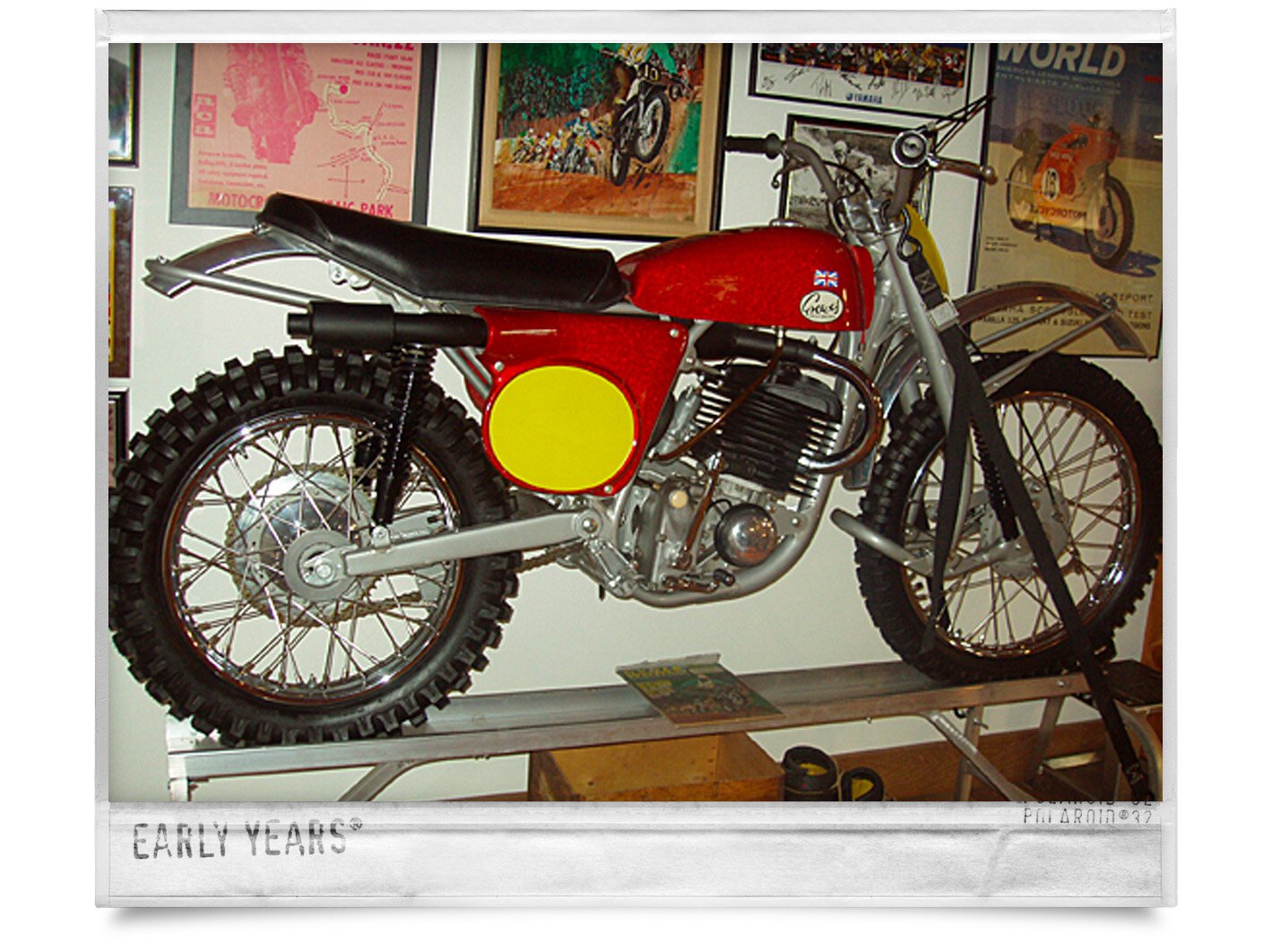Greeves 250cc Anglian Trials / 1967
Magazine test rider, Mike Bashford states in the October 1966 test of the Anglian, “The Anglian sets a hard-to-beat standard for a trials bike.” He goes on to comment on the instant power that could be re-applied – not desperately, but gently and smoothly – after a near-stop on a steep bank.
The Greeves Anglian was a benchmark for performance and reliability for a Trials machine. The Anglian was available with the standard leading link forks and/or for about $50.00 more, a Ceriani telescopic model was also available. Traditional Greeves riders preferred the leading link, while newer riders preferred the telescopic fork.
American riders Tibby Thibodeau and Al Gendreau won the 1966 and 1967 New England Trials Championships on the Anglian. At the time, the New England Championships were the premier Trials event in the USA.
This example was lovingly restored to original condition by Matt Hilgenberg.
Greeves 250 Starmaker 24ME / 1963
By the end of the 1962 season the Greeves-modified 34A Villiers motor as used by the factory riders was beginning to show signs of fatigue. Not surprising as Greeves had increased the power by over 25% from the original Villiers engine. This was accomplished by using an aluminum cylinder featuring better porting, a larger carburetor, and improved exhaust design. Unfortunately, transmission, clutch, and crankshaft problems were becoming all too common. Out of frustration with Villiers, Greeves started development of its own engine.
Not wishing to lose the Greeves business, Villiers started development of and all new engine dubbed the Starmaker. It was a radically different design from the previous engines with a strengthened crank, duplex primary chain, and redesigned clutch and transmission. The most notable feature was the use of dual-Amal Monobloc carburetors that were set to open progressively. The hope was better bottom end power and high power at high speeds. Power output was promising at a reported 25 bhp at 6500 rpm.
In 1963, Greeves introduced the new Starmaker utilizing the new Villiers engine and for the first time a quieter exhaust that had been mandated by the ACU (Auto Cycle Union). The new model was designated the 24ME. The production run was only 89 units as Greeves had little confidence in the design.
Unfortunately Greeves was right. The machine was so bad that factory rider, Dave Bickers switched to rival brand Husqvarna in mid season. Many of the dealers that purchased these machines couldn’t even get them to run and customers were demanding own engines refunds. This signaled the end of the Greeves/Villiers relationship and Greeves began manufacturing their.
Greeves 250 Starmaker 24ME / 1963
By the end of the 1962 season the Greeves-modified 34A Villiers motor as used by the factory riders was beginning to show signs of fatigue. Not surprising as Greeves had increased the power by over 25% from the original Villiers engine. This was accomplished by using an aluminum cylinder featuring better porting, a larger carburetor, and improved exhaust design. Unfortunately, transmission, clutch, and crankshaft problems were becoming all too common. Out of frustration with Villiers, Greeves started development of its own engine.
Not wishing to lose the Greeves business, Villiers started development of and all new engine dubbed the Starmaker. It was a radically different design from the previous engines with a strengthened crank, duplex primary chain, and redesigned clutch and transmission. The most notable feature was the use of dual-Amal Monobloc carburetors that were set to open progressively. The hope was better bottom end power and high power at high speeds. Power output was promising at a reported 25 bhp at 6500 rpm.
In 1963, Greeves introduced the new Starmaker utilizing the new Villiers engine and for the first time a quieter exhaust that had been mandated by the ACU (Auto Cycle Union). The new model was designated the 24ME. The production run was only 89 units as Greeves had little confidence in the design.
Unfortunately Greeves was right. The machine was so bad that factory rider, Dave Bickers switched to rival brand Husqvarna in mid season. Many of the dealers that purchased these machines couldn’t even get them to run and customers were demanding own engines refunds. This signaled the end of the Greeves/Villiers relationship and Greeves began manufacturing their.
Greeves 250cc Challenger 24MX5 / 1967
Bert Greeves never planned to become a motorcycle manufacturer. Tom White never planned to have a motorcycle museum. While this bike was the culmination of Greeve’s early years of building invalid carriages, this machine was the start of Tom’s collection.
Greeves was by far the most popular off-road 2-stroke in America in the early 1960’s. With its Earl’s type forks and aluminum I-beam frame, Greeves was easily distinguished from other brands. This example, the 1967 Challenger was at the beginning of the end, so to speak in the popularity of the Greeves motorcycle. As motocross mania swept America, the lighter-weight Husky’s and CZ’s became the tool of choice.
Top Greeves riders included Dave Bickers, Bryan Wade, and Gary Bailey. Please enjoy this fine example restored by Denny Berg back in 1989 when he owned the Time Machine Motorcycle Works.
Greeves 380 Griffin (1969)
INFO COMING SOON.




